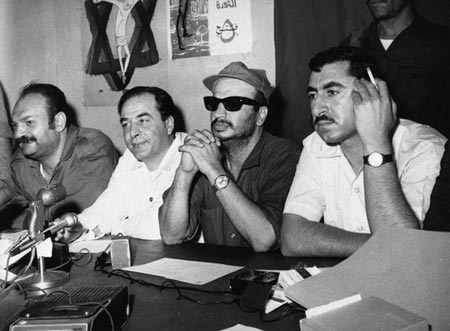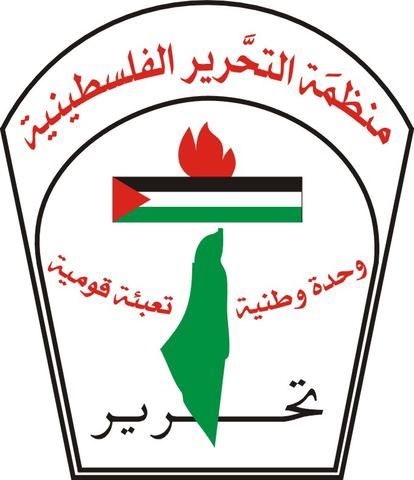Palestine Liberation Organization (PLO): History & Overview

Yasser Arafat with Democratic Front for the Liberation of Palestine leader,
Nayef Hawatmeh and Palestinian writer Kamal Nasser at press conference in Amman (1970)
The Palestine Liberation Organization (PLO) is undoubtedly one of the most infamous terrorist organizations around the world. Created in 1964 during the Arab League Summit in Cairo, the PLO’s originally-stated goal was the “liberation of Palestine” through armed struggle while seeking to destroy the existence of Zionism in the Middle East.
|
|
It was not long before that the group splintered into various factions, all of whom believed they knew the best way to achieve liberation for the Palestinians. The most notable of these groups were the Popular Front for the Liberation of Palestine (PFLP), Popular Democratic Front for the Liberation of Palestine (DFLP), Popular Front for the Liberation of Palestine - General Command (PFLP-GC), and the Fatah. While each of these factions were independently controlled, they all remained more-or-less under the umbrella of the PLO.
By 1967, the PLO had decided that their primary goal was the destruction of the State of Israel and revised its charter in 1968. Over the next ten years, this goal was the primary focus of the massive terrorist campaign by which their reputation was formed. This terror war caused hundreds of casualties, on both sides, with very little to show in return for the Palestinian cause. Therefore, in PLO the PLO made a conscious decision to alter its focus from based purely on terrorism to one that would include the diplomatic and political elements necessary for meaningful dialogue.
The PLO’s partial-reversal in ideology created unhappiness among many of its followers who felt that the organization was not finding its mark. This led to the creation of yet another splinter group called the Rejectionist Front. It was at this time that Yasser Arafat and his group, Fatah, took over the leadership of the PLO.
Things began to change quickly when the PLO gained international recognition from the United Nations as the primary representative of the Palestinian people. Arafat deftly manipulated the organization from one perceived by the West as barbaric into one considered a freedom movement with legitimate claims. Israel, perhaps sensing the growing sympathy, redoubled its efforts to eliminate the Palestinian threat.
In 1982, the Israel Defense Forces launched the First Lebanon War, sweeping into Beirut and forcing the PLO to flee from its bastion. In a decision that radical Palestinians resented, Arafat agreed to come to the bargaining table to discuss peace with Israeli leaders. Little came of these talks, and soon after dissension within the ranks of the PLO became more pronounced and some of the moderate leaders were assassinated.
Perhaps in an attempt to reconcile with these dissenters, Arafat decided to provide support for the hijacking of a major cruise ship. The ship that was selected was the Achille Lauro and what would happen next would do more damage to the reputation of the PLO than anything that had happened previously. Together with operatives from the PLF, terrorists seized the vessel and took the entire ship hostage. In a cowardly and reprehensible act, members of the team shot to death a wheelchair-bound Jewish passenger named Leon Klinghoffer, then dumped his body overboard. World response was swift, condemning, and slow to recover.
By 1988, Arafat had taken the diplomatic road one step further when he not only announced the right of the state of Israel to exist but renounced PLO terrorism. The perceived commitment to these ideals caused Israel to finally agree to serious talks with the PLO. The result of these discussions was that today the Palestinian people live under partial self-rule and seem on the way to obtaining the homeland they have yearned for years. In recent years, Palestinian youths have become disillusioned by what they perceive as the plodding nature of the PLO in regard to its pursuit of an independent Palestinian nation. Many of these followers have joined the either HAMAS or Hizballah. On September 9, 1993, in letters to Israeli Prime Minister Rabin and Norwegian Foreign Minister Holst, PLO Chairman Arafat committed the PLO to cease all violence and terrorism.
On September 13, 1993, the Declaration of Principles between the Israelis and Palestinians was signed in Washington, DC. Between September 9 and December 31, the PLO factions loyal to Arafat complied with this commitment except for one, perhaps two, instances in which the responsible individuals apparently acted independently. Two groups under the PLO umbrella, the Popular Front for the Liberation of Palestine (PFLP) and the Democratic Front for the Liberation of Palestine-Hawatmeh faction (DFLP-H), suspended their participation in the PLO in protest of the agreement and continued their campaign of violence.
Source: The Terrorism Research Center.
Photo: Public domain via Wikimedia.



